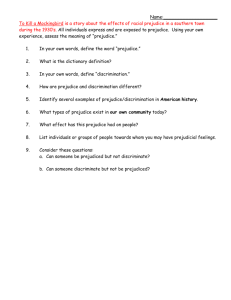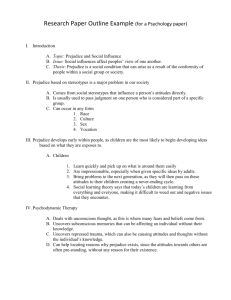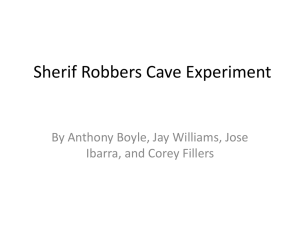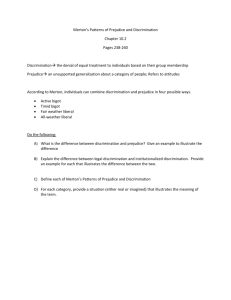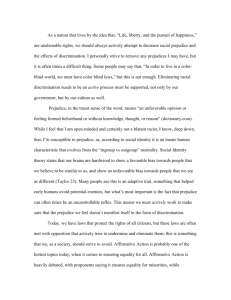→CHAPTER 14: ATTITUDES, PREJUDICE AND DISCRIMINATION
advertisement
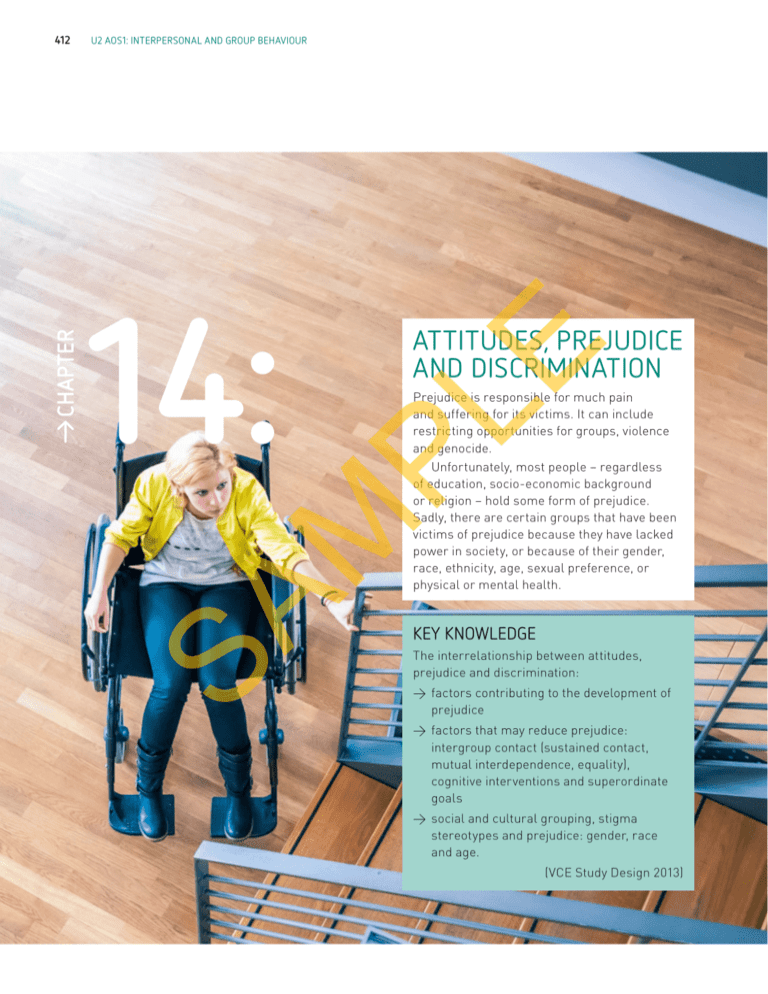
U2 AOS1: INTERPERSONAL AND GROUP BEHAVIOUR E Prejudice is responsible for much pain and suffering for its victims. It can include restricting opportunities for groups, violence and genocide. Unfortunately, most people – regardless of education, socio-economic background or religion – hold some form of prejudice. Sadly, there are certain groups that have been victims of prejudice because they have lacked power in society, or because of their gender, race, ethnicity, age, sexual preference, or physical or mental health. PL M 14: ATTITUDES, PREJUDICE AND DISCRIMINATION SA →CHAPTER 412 KEY KNOWLEDGE The interrelationship between attitudes, prejudice and discrimination: → factors contributing to the development of prejudice → factors that may reduce prejudice: intergroup contact (sustained contact, mutual interdependence, equality), cognitive interventions and superordinate goals → social and cultural grouping, stigma stereotypes and prejudice: gender, race and age. (VCE Study Design 2013) CH 14: ATTITUDES, PREJUDICE AND DISCRIMINATION The interrelationship between attitudes, prejudice and discrimination > Examples of prejudice and discrimination > Effects of prejudice and discrimination Formation of prejudice > Learning > Competition > Intergroup conflict: In-groups and out-groups > Threatening of social identity > Social and cultural grouping and stereotyping > Stigmatising > Scapegoating Education Intergroup contact Cognitive interventions Superordinate goals Direct experience SA Preventing and reducing prejudice M PL Defining prejudice and discrimination E CHAPTER OVERVIEW Defining prejudice and discrimination Prejudice is an unfavourable or negative attitude towards a group of people, based on insufficient or incorrect information about the group to whom it is directed. Note that prejudice is towards an identifiable group or an identifiable member of a group, not towards an isolated individual. Discrimination is the action that expresses the attitude of prejudice. Prejudice is a form of anti-social behaviour, and it is a cause for concern in all communities. It is present in most cultures, and has been evident throughout history. It causes stress and tension between groups, and harm to the victims. 413 U2 AOS1: INTERPERSONAL AND GROUP BEHAVIOUR FIGURE 14.1 A bilingual sign from the apartheid era of South Africa designates a beach ‘for whites only’ A negative attitude towards a group is not always necessarily prejudice, however. For example, it is common for members of a society to have a negative attitude towards a group of people who have been found guilty in a court of law for committing criminal activity, such as murder. To be able to moderate and prevent the effects of prejudice, it is important to understand why people are prejudiced, and how prejudice may be formed. Note that while prejudice and discrimination are closely related concepts, they are slightly different. Prejudice can result in acts of discrimination. In other words, prejudice is a feeling/behaviour, whereas discrimination is action. It is possible for one of these to exist without the other. For example, you may recall from Chapter 12 LaPiere’s (1934) study, which found that although many restaurant owners were prejudiced against Chinese people, very few demonstrated discrimination by refusing service to them. E 414 PL The interrelationship between attitudes, prejudice and discrimination You have already studied the structure of attitudes in Chapter 12. Prejudice is another example of an attitude, and therefore the tricomponent model of attitudes (see page 299) can be applied to prejudice. TABLE 14.1 The tricomponent model of attitudes applied to prejudice M PREJUDICE The categorisation of people, and beliefs about the people that are put into these categories, especially stereotyping Affective Feelings that are either friendly or hostile towards a group of people SA Cognitive DISCRIMINATION Behavioural FIGURE 14.2 Older people can experience prejudice when trying to find employment. Behaviour towards a group of people For example, prejudice against elderly people (ageism) includes negative beliefs about elderly people (cognitive component), a strong feeling of dislike towards the elderly (affective component) and the action of discriminating against them (behavioural component). CH 14: ATTITUDES, PREJUDICE AND DISCRIMINATION 415 EXAMPLES OF PREJUDICE AND DISCRIMINATION The most obvious examples of prejudice are based on gender, race, ethnicity, age, sexual preference, physical or intellectual disability, or mental illness. Table 14.2 contains examples of prejudice. TABLE 14.2 Examples of prejudice PREJUDICE Sexism Gender Racism Ethnicity or race Ageism Age Homophobia Sexual preference Disability Physical or intellectual disability, or mental illness E PREJUDICE TYPE M TABLE 14.3 Examples of discrimination PL In most Western nations, much has been done to try to reduce these prejudices through education and legislation. There is still much work to do, however, because prejudice can be difficult to prevent and difficult to eradicate once it has been established. Although laws in Australia prevent discrimination, some prejudice can be difficult to detect. It is also subtly embedded in everyday language, culture and social dialogue. Table 14.3 presents some types of discrimination. DESCRIPTION EXAMPLE Reluctance to help Reluctance to help other groups to improve their position in society by passively or actively declining to assist their efforts Inadequate facilities for physically disabled employees in a workplace Tokenism Publicly giving trivial assistance to a minority group in order to avoid accusations of prejudice and discrimination Employing one woman in a predominantly male organisation Reverse discrimination Publicly being prejudiced in favour of a minority group in order to deflect accusation of prejudice and discrimination Deliberately favouring a minority group by making it company policy to employ a percentage of minority group members – but this sometimes turns out to be discriminatory because the members of the minority group are singled out and treated differently once employed by the company SA DISCRIMINATION FIGURE 14.3 In 2009, Queenslander Samantha Scafe was forced to pay for a second seat on a plane ‘for other people’s comfort’. 416 U2 AOS1: INTERPERSONAL AND GROUP BEHAVIOUR E PL 14.1 1 Write your own example and explanation of the three components of prejudice/ discrimination. 2 Write your own examples to illustrate three forms of prejudice. 3 Conduct a brief internet research on two of the examples of discrimination outlined in Table 14.3. EFFECTS OF PREJUDICE AND DISCRIMINATION M Victims of prejudice may suffer a range of effects that include physical, psychological and social disadvantage, low self-esteem, limited ambition, and physical and verbal abuse. Some examples are set out in Table 14.4. TABLE 14.4 Examples of the effects of prejudice and discrimination EFFECT SA RE VIEW FIGURE 14.4 Football coach Matthew Fittolani – pictured with his son Jet – has been banned from coaching as his wheelchair is considered to be a hazard. EXAMPLE Low self-esteem Crude acts of prejudice on a regular basis can damage selfesteem; e.g. insults, denial of equality, violence Disadvantage/failure Being denied access to resources in society that are necessary for success; e.g. education, health, housing, employment Self-fulfilling prophecies Expectations and assumptions about group members will influence interaction with members of that group and eventually change their behaviour so that it is in keeping with the original expectations and assumptions Violence and genocide Overt acts of prejudice that include physical harm; e.g. apartheid in South Africa, segregation in the United States and, in some cases, deliberate acts of extermination such as the Holocaust in the Second World War CH 14: ATTITUDES, PREJUDICE AND DISCRIMINATION 417 Formation of prejudice A range of influences contribute to the formation and maintenance of prejudice. These include learning, competition, intergroup confl ict, threat to social identity, social and cultural grouping, stigmatising, stereotyping and scapegoating. LEARNING Because prejudice is an attitude, the factors that influence the formation of prejudice are the same as the factors that influence the formation of attitudes. As with all attitudes, operant conditioning, observational learning, parents, peers and the media are significant influences in the formation of prejudice (see Chapters 12 and 13). COMPETITION SA M PL E Wherever there is competition between social groups for scarce resources, it is possible that hostility and prejudice will develop. There are numerous historical as well as current and everyday instances of this; for example, competition for the highest marks in school subjects; competition for jobs; performance in sport; or competition over land. In a classic study, Sherif and colleagues (1961) found that, when placed in a competitive environment, children developed prejudice towards perceived rivals (see the ‘Robbers Cave’ experiment key study on page 357). Immigrant groups may experience prejudice from people already living in the country where they settle, because they are rivals competing for jobs. This competition may lead to psychological processes occurring, including: - intergroup confl ict (in-groups and out-groups) - threatening of social identity - social categorisation and stereotyping - stigmatising - scapegoating. INTERGROUP CONFLICT: IN-GROUPS AND OUT-GROUPS Intergroup confl ict occurs where there is: - the existence of groups - competition between groups for scarce resources. People in groups sometimes perceive themselves as ‘us’ (the in-group) and ‘them’ (the out-group). Members of a perceived in-group tend to classify themselves as being better than people who they perceive as belonging to an out-group. For example, people from a specific ethnic group may see themselves as the in-group who possess what they believe to be superior physical or intellectual qualities to all other ethnic groups (the out-groups). The ‘cool group’ at school may consider itself to be the in-group because they possess qualities that they believe to be superior to the out-group. FIGURE 14.5 In-group formation was exemplified famously by the President of the United States, George W. Bush, on 20 September 2001. During a televised address to a joint session of congress, President Bush launched the ‘war on terror’ when he posed the question: ‘Are you with us or against us?’ 418 U2 AOS1: INTERPERSONAL AND GROUP BEHAVIOUR THREATENING OF SOCIAL IDENTITY E FIGURE 14.6 The Cronulla riots in 2005 were a series of confrontations between different ethnic groups. Social identity theory (Tajfel & Turner 1979) suggests that: - people categorise themselves into a group and gain their individual identity by belonging to the group - group membership gives the members enhanced self-esteem - people need to feel they belong to ‘the best’ group and therefore put other groups down. An example of social identity is people taking pride in belonging to a group such as a football club, church, school, ethnic group or circle of friends. Prejudice can form when people feel the need to protect their self-esteem by belonging to a particular group and behaving negatively towards other members of a community. When social identity is threatened, it means that group members may feel that their self-esteem and personal identity is being attacked. This can sometimes result in prejudice and discrimination; for example, race riots or bullying of members of the out-group. PL SOCIAL AND CULTURAL GROUPING AND STEREOTYPING SA M Social categorisation is our natural human tendency to classify people into groups based on characteristics that we perceive them to have in common. Categorising people is a means of organising the information that we have about them; for example, through the use of labels such as boffins, tech heads, rev heads, bimbos, spivs, wimps and toffs. Social categories that are based upon what we perceive to be typical of a particular group are termed stereotypes. Stereotyping leads to pre-judging people according to the categories we put them into. It can often lead to very inaccurate perceptions of individuals who are within a group. It includes: - categorising people into groups: this is usually based on appearance, for example gender, ethnicity, race, physical ability or disability and age; but can also be based on culture, sexuality, social class, occupation, intelligence and so on - assuming that all members of the group are the same (for example, Homer Simpson is a stereotypical ‘stupid, white, working-class American man’, or Paris Hilton is a stereotypical ‘dumb blonde’). TABLE 14.5 Common stereotypes associated with population groups in Western cultures GENDER Women Emotional, submissive, irrational, physically weak Men Unemotional, dominant, logical, physically strong AGE FIGURE 14.7 The stereotyping of blonde females as ‘Barbie dolls’ is often reinforced by the media in their advertising. Young adults and teenagers Risk-takers, impulsive, promiscuous, binge drinkers, irresponsible Elderly people Feeble, forgetful, slow, intolerant, deaf STEREOTYPES Write descriptions to stereotype the people in each photograph in Figure 14.8. PL E You may have noticed that you were very quick to find the words to label these people. This is because you probably relied on the stereotypes that you have formed since you were young. M FIGURE 14.8 Stereotypes are not necessarily accurate representations of people Function of stereotypes SA Stereotypes help us to organise our knowledge of people quickly, especially when we meet new people. Unfortunately, stereotypes tend to be incorrect or overgeneralisations about group members. Any individual usually will not possess all of the characteristics that we have assumed and therefore individual differences are overlooked. Stereotypes play a large role in prejudice. They can be both positive and negative. Research suggests that prejudicial stereotypes are very accessible and tend to operate automatically without conscious thought. Stereotypes may be difficult to change and they persist because: - They are highly subjective – the stereotype a person holds means that the person will be likely to see only what he or she expects to see in other people, especially minority groups; for example, all male members of a particular ethnic group may be perceived as violent towards women. - Biases may help perpetuate stereotypes where positive aspects of group members are explained for reasons other than the good qualities of the minority group; for example, when a female employee succeeds in a maledominated industry, a sexist male might attribute her performance to the support she has received from her male colleagues rather than to her own aptitude. 14.1 419 INVES TIGATE CH 14: ATTITUDES, PREJUDICE AND DISCRIMINATION INVES TIGATE 420 U2 AOS1: INTERPERSONAL AND GROUP BEHAVIOUR STEREOTYPING 1 Write a description of a stereotype for: 14.2 a two occupations b two nationalities (for example, French, Japanese, American). 2 Explain why these stereotypes are inaccurate. 3 Design an exercise that might help members of your community to reduce the use of stereotypes. STIGMATISING ↙ Did you know? E PL M SCAPEGOATING INVES TIGATE SA The origin of the term ‘scapegoat’ comes from a biblical story, where it is said that a goat carrying the sins of the people was driven into the wilderness to die as part of the Yom Kippur (atonement) ceremonies. The term is used to refer to an often innocent person who is blamed and suffers for the misdeeds committed by other people. Stigma is where a group of individuals is perceived by others to possess qualities that are undesirable, and is therefore rejected. In other words, stigma is a negative label for members of a group who possess a set of qualities that a particular community deems to be undesirable. Stigmatised people are often the victims of discrimination, and are ignored or rejected by other members of a society or community. FIGURE 14.9 What stigma may be applied to this person just because of his appearance and location? Is this discrimination? Scapegoating is sometimes referred to as the frustration–aggression theory (Dollard et al. 1939). It involves: - socially frustrating conditions, such as economic depression and unemployment - the need for frustration to be released, which results in blame being directed towards a ‘scapegoat’ – usually a minority out-group – leading people to discriminate against and perpetrate verbal and physical abuse towards that group. DISCRIMINATION 1 Describe a situation where you believe that you have experienced discrimination. 14.4 2 Describe a situation where you believe that your prejudices have influenced your behaviour towards another group or a member of another group. 3 Describe your behaviour from the point of view of the person who experienced your discrimination. CH 14: ATTITUDES, PREJUDICE AND DISCRIMINATION Preventing and reducing prejudice How can prejudice be prevented or reduced? Prejudice can be difficult to change; however, education, intergroup contact, cognitive interventions, setting superordinate goals and direct experience have been successful to an extent. Education The formation of prejudice can be impeded through education programs in schools where children are taught about tolerance, the consequences of prejudice, and what constitutes discrimination. Intergroup contact M PL E Prejudice can be reduced through direct contact between groups of people who have prejudicial attitudes towards each other. However, direct contact alone will not work; the following factors are also essential: - sustained, interpersonal interactions contact between the groups - mutual interdependence where the groups engage in cooperative activities - equal status between the groups - social norms favouring the reduction of prejudice. These factors were evident in the reduction of prejudice in the Robbers Cave key study experiment (see page 422). Cognitive interventions SA Prejudice can be countered by reducing stereotyping through cognition. For example, making information available to individuals reduces stereotypes by minimising irrelevant information about groups of people. It is important to make sure that this information is noticed, and to provide sufficient time for individuals to process information that contradicts stereotypes. Superordinate goals Working towards a common goal can facilitate knowledge and understanding between groups. However, the goal must be shared, and it must require the contribution of both groups. FIGURE 14.10 Education helps to reduce prejudice and teach tolerance and acceptance. 421 422 U2 AOS1: INTERPERSONAL AND GROUP BEHAVIOUR Direct experience Construct a table to summarise the factors that contribute to the formation of prejudice and the ways of preventing and reducing prejudice, including practical examples. REDUCING PREJUDICE → PL Design an activity that is aimed at reducing prejudice in your community. It could involve any of the previously mentioned options. Think about how you would promote your activity to the community as well. M 14.5 E 14.3 THE ROBBERS CAVE EXPERIMENT A study by Sherif and colleagues (1961), set in a school holiday camp in the Robbers Cave Park in Oklahoma in the United States, involved ‘campers’ who were mostly 11- and 12-year-old boys. The study investigated the causes of, and possible solutions to, intergroup conflict. The experiment was conducted in three stages. SA KE Y S TUDY INVES TIGATE RE VIEW Directly experiencing another culture or lifestyle – either in another country or within our own – can help reduce prejudice. This could include learning another language, learning about another culture and participating in another culture. Direct experience can result in better knowledge and understanding, and can reduce ignorance. Stage 1: Setting up camp The boys were divided at random into two groups. Each was initially unaware of the other group, but would gradually become aware. Stage 2: Setting up rivalry between groups A series of contests was set up to create rivalry between the two groups, who had named themselves the Rattlers and the Eagles. There was hostility once each group became aware of the other’s existence; insults were hurled, and they accused each other of ‘using our campground’ and ‘our baseball diamond’. For the first two days of the contests, there was good sportsmanship, but this did not last: there were food fights; the Eagles stole the Rattlers’ flag CH 14: ATTITUDES, PREJUDICE AND DISCRIMINATION When the Eagles won the final of the contest, the Rattlers raided their cabin and stole the prizes. A fist-fight developed and the staff had to intervene to prevent injury. Each group had developed negative stereotypes of the other group, and a contrasting positive stereotype of themselves. Next morning there was another food fight, but the researchers again provided a cooperation task. This time, a truck carrying the next week’s supplies had become bogged. It needed all of the boys working together to push it out of the mud. After this, the rivalry between the groups diminished. The cooperative activities forced the groups to work together peacefully. The prejudices of the members of each group were reduced. The Rattlers even used the money that they had won in the contest to buy treats for all the boys in both groups. PL Stage 3: Setting up cooperation between groups bottles, did not object to the Eagles taking a first turn at drinking water from the taps. E and burned it; the Rattlers raided the Eagles’ cabin, stole the group leader’s jeans and used them as a flag; and the Eagles raided the Rattlers’ cabin, spreading dirt and upending beds. 423 This study demonstrated that prejudice and hostility arising from competition can be overcome by simply getting groups to know each other by working together towards a superordinate goal (a goal that neither of the groups could have achieved alone). This meant that the boys began to think of themselves as being part of a larger, combined group. RESEARCH METHODS 1 Identify the dependent and independent variables in the Robbers Cave experiment. 2 Write a hypothesis for this study. 3 To whom can the results of this study be applied? 4 Identify ethical issues that would arise if this study was to be conducted in Australia today. 14.6 INVES TIGATE SA M Researchers tried to reduce friction between the groups by having them socialise at pleasant events such as Fourth of July fireworks, but this was not successful. However, when told that there might be a water shortage that was possibly due to ‘vandals’ damaging the water tank, the groups discussed the problem together, and worked collaboratively towards a solution. Once the tank had been repaired, the Rattlers, who had water 424 U2 AOS1: INTERPERSONAL AND GROUP BEHAVIOUR PL SA M 14: → Prejudice is a negative attitude about a social group. It contains cognitive, affective and behavioural components. → Discrimination is the action of prejudice. It is the behavioural component of an attitude. → Some obvious and pervasive prejudices are based on mental illness, age, gender, ethnicity, race and sexual preference. → Examples of discrimination include reluctance to help, tokenism and reverse discrimination. → Some prejudice and discrimination is less obvious; for example, a reluctance to assist if needed. → Reverse discrimination occurs when actions in favour of a minority group mean the majority group is treated differently. → Victims of prejudice may suffer physical, psychological and social disadvantage, low self-esteem, limited ambition, and physical and verbal abuse. E →CHAPTER SUMMARY CH 14: ATTITUDES, PREJUDICE AND DISCRIMINATION E → Education programs in schools and the media can help to reduce prejudice. → Direct contact between different groups can reduce prejudice, provided there are interpersonal interactions, mutual interdependence, equal status and appropriate social norms. → Reducing stereotyping can be achieved through efforts to alter people’s negative cognitions about others. → Understanding and interacting with different cultures can reduce prejudice and discrimination. → The Robbers Cave experiment demonstrated ways in which prejudice can be reduced. SA M PL → In some countries, legislation has been made to outlaw and prevent some forms of prejudice. → Prejudice can be formed and maintained through learning, or through competition for scarce resources, where people direct their frustration towards minority groups or weaker members of a community who become scapegoats. → Attempts to explain competition-based prejudice include the natural tendency of humans to classify people into groups based on common factors. This forms attitudes to strengthen the group, but can also be used to distinguish it as being superior to another group. Explanations include in-groups and out-groups, social identity theory, social categorisation, stigmatising and stereotyping. → Prejudice can be difficult to change, but education, intergroup contact, cognitive interventions, superordinate goals and direct experience can help to reduce prejudice. 425 426 U2 AOS1: INTERPERSONAL AND GROUP BEHAVIOUR → TEST YOUR UNDERSTANDING MULTIPLE CHOICE 7 Discrimination is: a the same as prejudice b unfair treatment of a group c making people do things they do not want to do d none of the above. PL 2 Which of the following is not characteristic of reverse discrimination? a publicly declaring support for the minority group b prejudice is eliminated c holding deep prejudice against the minority group d all of the above. 6 The normal human tendency to sort people into groups based on common characteristics is called: a social categorisation b prejudice c discrimination d classification. E 1 Which of the following is not a component of prejudice according to the tricomponent model of attitudes? a affective b receptive c behavioural d cognitive. M 3 When people are stereotyped into groups: a they are all seen as being similar b all the members are viewed negatively c individual differences are overlooked d none of the above. 8 Prejudice is an attitude about: a a social group b an individual c a majority group d a population. SA 4 The Robbers Cave experiment showed that: a prejudice can be artificially created b competition can create prejudice c cooperation can reduce prejudice d all of the above. 5 Members of groups can experience negative prejudice when: a members of the group have little power in society b society has laws against discrimination c their group is a majority in the population d all of the above. 9 Reducing prejudice includes: a making sure the groups are equal in status b making sure the groups share a common goal c making sure the groups are equal in numbers d (a) and (b). 10 Discrimination is: a deliberately disadvantaging a social group b the behavioural component of prejudice c usually directed towards a perceived outgroup d all of the above. 11 Ageism is best defined as: a prejudice against young people b prejudice against old people c prejudice against middle-aged people d prejudice against a particular age group. 427 CH 14: ATTITUDES, PREJUDICE AND DISCRIMINATION 13 Prejudice is only directed towards: a individuals b women c groups d children. 18 What is the name for the situation where people go out of their way to favour a member of a group against which they are prejudiced more than if they were not members of that group? 1 mark 19 is a small or trivial act towards members of a group as a way of avoiding activity in larger, more positive acts for the group. 1 mark 20 is an extreme form of prejudice where the extermination of a whole social group is expressed. PL 14 Social categorisation is: a the human tendency to discriminate b the human tendency to hold prejudices c the human tendency to sort people into groups d none of the above. SHORT ANSWER E 12 Prejudice is: a an unfavourable attitude directed towards another group of people b a favourable attitude directed towards another group of people c neither (a) nor (b) d both (a) and (b). M 15 Competition for scarce resources is likely to: a foster cooperation between groups b foster scapegoating c foster superordinate goals d create competition. SA 16 The Robber’s Cave study showed that a antagonism between groups can be artificially created b once antagonism between groups develops, it is impossible to eliminate c putting antagonistic groups in situations where they must cooperate can eliminate the antagonisms d both a & c are correct 17 When people in group A stereotype others in group B, the Group A people tend to a see all members of group B as being the same b view all the others on group B negatively c look for information that reinforces the differences between those in group B and those in their own group. d both a & c are correct 1 mark 21 Explain why prejudice is an attitude. 2 marks 22 Explain how the frustration–aggression theory helps us to understand prejudice. 2 marks 23 Explain how stereotypes are formed. 2 marks 24 Name and describe three forms of prejudice. 6 marks 25 Explain the difference between prejudice and discrimination. 2 marks 26 What makes behaviour antisocial? 2 marks 27 i Describe an activity that you believe might help to reduce prejudice against people who have been the target of prejudice that has come from stereotypes. 2 marks ii Provide evidence to support the activity that you have outlined in i. 4 marks
